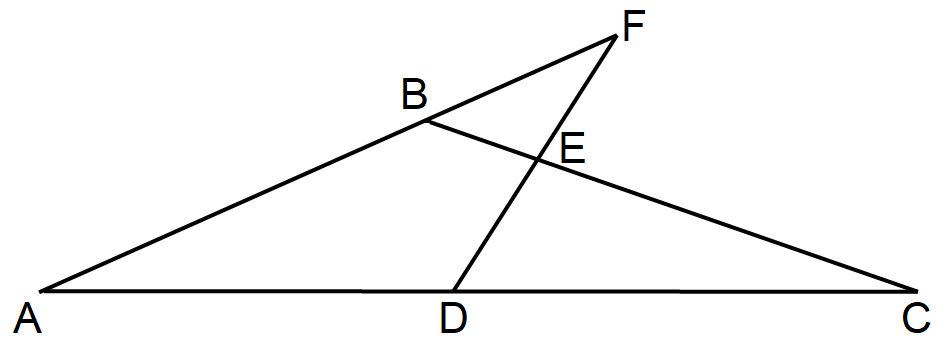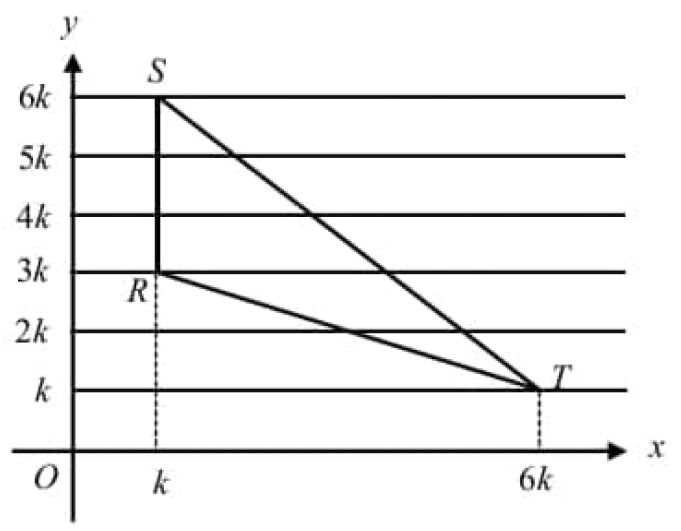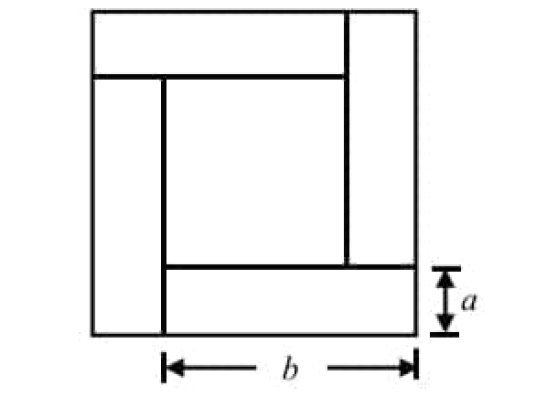HOW TO FIND MISSING PYTHAGOREAN TRIPLE
The set of positive integers {a, b, c} is a Pythagorean triple if it obeys the rule
a2 + b2 = c2
Find k if the following are Pythagorean triples:
Example 1 :
{8, 15, k}
Solution :
From the given numbers, the largest number is 15.
k2 = 82 + 152
k2 = 64 + 225
k2 = 289
k = 17
So, {8, 15, 17} is a Pythagorean triple.
Example 2 :
{k, 24, 26}
Solution :
Let k2 + 242 = 262
k2 + 576 = 676
k2 = 676-576
k = √100
k = 10
Example 3 :
{14, k, 50}
Solution :
Let 142 + k2 = 502
196 + k2 = 2500
k2 = 2500-196
k = √2304
k = 48
Example 4 :
For what values of n does {n, n+1, n+2} form a Pythagorean triple?
Solution :
Let n2 + (n+1)2 = (n+2)2
n2+n2+2n+1 = n2+4n+4
2n2-n2+2n-4n+1-4 = 0
n2-2n-3 = 0
(n-3)(n+1) = 0
n = 3 and n = -1
So, for n = 3 the given set will create Pythagorean triple.
Example 5 :
Show that {n, n+1, n+3} cannot form a Pythagorean triple.
Solution :
Let n2 + (n+1)2 = (n+3)2
n2+n2+2n+1 = n2+6n+9
2n2-n2+2n-5n+1-9 = 0
n2-3n-8 = 0
It is not factorable. So, by solving this quadratic equation, we will not get integer value for n.
Therefore the given set of numbers will not create Pythagorean triple.
Example 6 :
A rectangle with diagonals of length 20 cm has sides in the ratio 2 : 1.
Find the :
a) perimeter
b) area of the rectangle
Solution :
Let 2x and x be the length and width of the rectangle.
In a rectangle, the diagonal will bisect the rectangle into two right triangles.
Here 2x, x and 20 are Pythagorean triples.
So, (2x)2 + x2 = 202
4x2+x2 = 400
5x2 = 400
x2 = 400/5
x2 = 80
x = √80
Perimeter of the rectangle = 2(2x+x)
= 2(3x)
= 6x
Perimeter of the rectangle = 6√80
= 24√5
Area of the rectangle = 2x(x)
= 2x2
= 2(80)
= 160 cm2
Example 7 :
A rhombus has sides of length 6 cm. One of its diagonals is 10 cm long. Find the length of the other diagonal.
Solution :
In a rhombus, the diagonals will bisect each other at right angle and all the sides will have equal length.
Length of diagonal = 10 cm
Half of the diagonal = 5 cm
Let x be the half length of another diagonal.
So, {6, x and 5} is Pythagorean triple.
62 = x2 + 52
x2 = 36-25
x2 = 11
x = √11 ==> 3.31
2x = 3.31(2)
2x = 6.62
Length of another diagonal is 6.62 cm.
Example 8 :
A square has diagonals of length 10 cm. Find the length of its sides.
Solution :
Length of each side be x.
x2 + x2 = 102
2x2 = 100
x2 = 50
x = √50
x = 5√2
So, side length of square is 5√2 cm.
Example 9 :
A 9 m ladder is placed against a wall. The foot of the ladder is 1.5m from the foot of the wall. How far up the wall does the ladder rea

Solution :
From the picture given above, using Pythagorean theorem
92 = x2 + 1.52
81 = x2 + 2.25
81 - 2.25 = x2
x2 = 78.75
x = √78.75
x = 8.87 m
So, the required height of the wall is 8.87 m.
Example 10 :
Shown is a square with side length 5 cm. Find the length of the diagonal

Solution :
Since it is square, all sides are equal.
52 + 52 = x2
x2 = 25 + 25
= 50
x = √50
x = √(2 x 5 x 5)
x = 5√2
So, the missing side is 5√2 cm.
Example 11 :
Shown is a right angle triangle. Calculate:
(a) the perimeter of the triangle.
(b) the area of the triangle

Solution :
Let x be the missing side,
252 = 72 + x2
625 = 49 + x2
x2 = 625 - 49
x2 = 576
x = √576
= √(24 x 24)
= 24 cm
So, the missing side is 24 cm.
a) Perimeter of the triangle = 25 + 7 + 24
= 56 cm
b) Area of triangle = (1/2) x base x height
base = 24 cm and height = 7 cm
= (1/2) x 24 x 7
= 12 x 7
= 84 cm2
Example 12 :
A rectangle is 20 cm long and 8 cm wide. Find the length of the diagonal of the rectangle.

Solution :
Let the diagonal of the rectangle be x.
x2 = 202 + 82
= 400 + 64
x2 = 464
x = √464
= 21.54 cm
So, the length of the rectangle is 21.54 cm.
Example 13 :
An airplane is lying from Redville to Leek. The airplane lies 50 miles East and then 180 miles South. How far is Leek from Redville directly?
Solution :

Let x be the unknown side.
x2 = 1802 + 502
= 32400 + 2500
= 34900
x = √34900
= 186.81 miles.
Example 14 :
A frame is made from wire. The frame is a trapezium Calculate the total amount of wire needed to make the frame. Give your answer to 1 decimal place.

Solution :

AB = 14 cm
EB = CD = 8 cm
AE = AB - BE
= 14 - 8
AE = 6 cm
ED = BC = 12 cm
In triangle AED,
AD2 = AE2 + ED2
= 62 + 122
= 36 + 144
= 180
AD = √180
= 13.41 cm
Kindly mail your feedback to v4formath@gmail.com
We always appreciate your feedback.
©All rights reserved. onlinemath4all.com
Recent Articles
-
Digital SAT Math Problems and Solutions (Part - 187)
Jun 14, 25 09:07 AM
Digital SAT Math Problems and Solutions (Part - 187) -
Digital SAT Math Problems and Solutions (Part - 186)
Jun 13, 25 04:41 AM
Digital SAT Math Problems and Solutions (Part - 186) -
Digital SAT Math Problems and Solutions (Part - 185)
Jun 11, 25 10:20 PM
Digital SAT Math Problems and Solutions (Part - 185)


